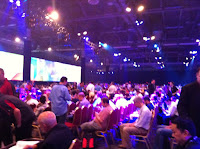Here's a couple of pics from prior to the start as the crowd is filing in:
- Intro video is on the screen. Project Octopus is mentioned... Links content to devices to people
- Dr. Herrod (CTO) is on the stage
- He is highlighting a few of the products
- We need to move above managing device -> What does the user really need?
- It's now about Universal Access from all devices at all times with high expectations
- Video about how the way we work and collaborate is changing
- it's not about provisioning machines, it's about user data and their access to the data
- IT still has control of the platform!
- users dictate the work style now with IT enabling this new style
- Dr. Herrod is back
- How do put all the devices, users, and data all together?
- Need to Simplify, extract from silos that exist today
- Manage all this in a new way
- Windows more manageable and secure View with ThinApp
- Focus going forward will be an App Catalog Service as well as Data Service
- He introduced the concept of a Unified Service Broker to connect all this together to provide Secure Universal Access
- He is taking us through each area in turn from the perspective of both the administrator and the user
- Talking about View 5 - showing automated pool creation with Link Clones. Creates about 1000 desktops in about an hour. More automation and provisioning in View
- App Catalog Service - New Project -> ThinApp Factory, patches and automation for applications ties into Project Horizon
- Project Horizon will be Windows apps as well as mobile apps
- ThinApp Factory allows you to create ThinApps easily and prepares them for insertion into the catalog -> It will fire up a virtual machine, install the app, and create the package, all automated
- Assign apps to groups and users for access so app catalog will be specialized per user for what the catalog will display
- Tracks user licenses upon application activation
- Onto to Data Service -> Project Octopus
- He mentions Dropbox - He many are using it and how many SHOULD be using it :)
- Dropbox service for the enterprise
- Policies based on users and groups depends on what you can share
- Controls the sharing of sensitive data, the idea of sharing expiration and also group based security
- Delivered via public and private cloud (no details given though)
- Now a demonstration from the user perspective
- Gives a demonstration of View 5 -> pulls up Windows 7 desktop
- App Catalog is provided after desktop, new user can activate and install apps based on their role in the enterprise
- User would have pre-populated user shares based on Project Octopus permissions
- Activate a mobile device from the App Catalog and it will push the applications and file sharing to the new phone
- App on the mobile phone will be a "VDI device" on the phone, apps appear on the phone in a new "enterprise area". It's a phone within a phone and you can switch contexts back and forth with Horizon Mobile on the mobile device
- More demonstrations about the Horizon Mobile
- Showing Excel modification on iPad using AppBlast
- Showing SocialCast on an iPad
- WAN based TCP/IP call on iPad
- AppBlast -> delivering applications over HTML5
- This is a labs project right now
- If you have a home phone, you can wipe the "work device" (the Horizon mobile device within a device) without wiping the personal device.
- It's all about managing data, people, and applications in a post-PC era
- Giving a demonstration of the upcoming rev to the iPad vSphere Client
- vMotion now enabled
- What does the back end to all of this look like?
- vSphere 5 is now available
- 200 new features
- It should just work and work well, that is the goal
- Talked VMware Go for a bit
- VSA is mentioned since Go is designed for SMB (small/medium business market)
- The VSA make it easy to deploy and manage shared storage using local servers instead of a SAN
- Now talking AutoDeploy for larger enterprises
- PXE boot stateless servers
- Talking performance
- Biggest virtual machine ever - over 1,000,000 iops!
- Performance guarantees
- How do we solve the noisy neighbor problem?
- Storage Pooling
- The concept of Tiered Storage and placement of vm's
- This allows critical apps to be Tier 1, less critical Tier 2, etc.
- Storage DRS, moving vm's around in pool
- The combination of all of these features allows for SLA's to be generated





No comments:
Post a Comment